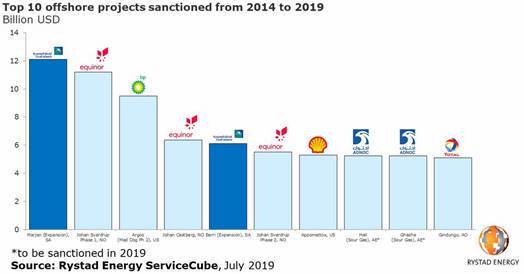Overall offshore project sanctioning in 2019 has surpassed the $50 billion mark, driven by Saudi Aramco’s recently announced $18 billion worth of project commitments associated with the Marjan and Berri expansion projects. This is yet another signal that the offshore industry has turned a corner and can reach a potential project commitment total of $123 billion in 2019, surpassing commitments in 2014 of $78 billion, according to Rystad Energy.
The Marjan Expansion alone is the largest field to be sanctioned globally since 2014. Later this year, the Hail and Ghasha Sour Gas projects, Lula’s Oeste FPSO in Brazil, and the feed gas systems to develop the Atum and Golfinho assets on the Area 1 LNG project are also expected to be sanctioned. Once that happens, four of the top 10 offshore projects since 2014 will have been sanctioned during this calendar year. Previously, the $4.7 billion Liza Phase 2 project was the largest offshore field to be sanctioned this year.
“With offshore free cash flows at nearly record highs, E&P’s are betting big on new projects. Offshore project sanctioning in 2019 looks ready to reach heights not seen since the $100 barrel of oil,” says Matthew Fitzsimmons, VP of Oilfield Service Research at Rystad Energy.

Back in 2014, 74 offshore projects were sanctioned for nearly $78 billion. Total alone was responsible for $24 billion of these projects by growing their portfolios in West Africa and Brazil. However, oil prices dropped, and operators thought twice about sanctioning new work. In 2016, sanctioning bottomed-out, with only $37 billion of offshore projects sanctioned.
For the offshore industry to reach $123 billion of potential project commitments in 2019, as forecasted in January by Rystad Energy, over $86 billion of 2H 2019 onshore and offshore commitments will require an oil price of at least $40 per barrel to breakeven. Rystad Energy cautioned that 15% of the potential $123 billion to be committed for offshore projects has a breakeven price over $60 per barrel. While that number has decreased to 13% since the time of publishing, it still means that $16 billion worth of projects are at high risk of not receiving funding at the time of their sanctioning decisions this year.

Follow us on social media: